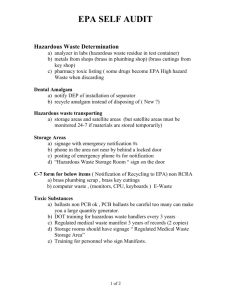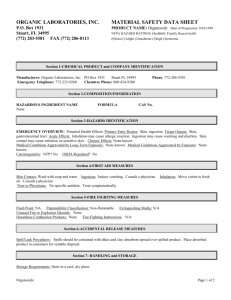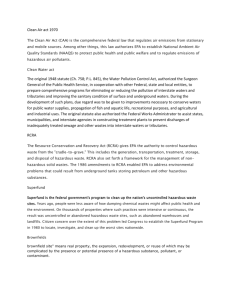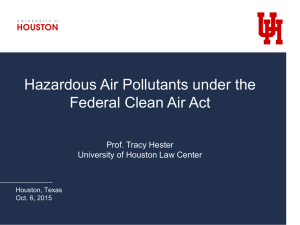Online Chemistry Course (OLCC) Chemical Safety: Protecting Ourselves And Our Environment
advertisement
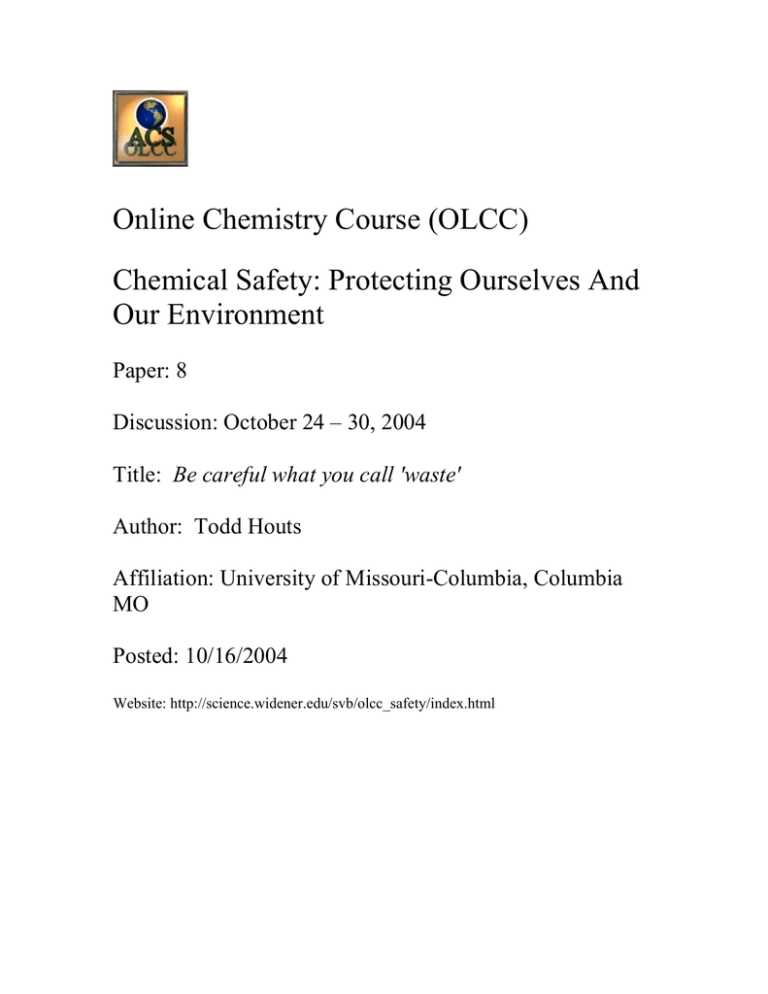
Online Chemistry Course (OLCC) Chemical Safety: Protecting Ourselves And Our Environment Paper: 8 Discussion: October 24 – 30, 2004 Title: Be careful what you call 'waste' Author: Todd Houts Affiliation: University of Missouri-Columbia, Columbia MO Posted: 10/16/2004 Website: http://science.widener.edu/svb/olcc_safety/index.html Be Careful What You Call “Waste” Todd Houts, CHMM University of Missouri-Columbia 8 Research Park Development Building Columbia, MO 65211-3050 Office: (573) 882-7018 Fax: (573) 882-7940 Email: houtst@missouri.edu Introduction Innumerable guides exist on managing excess materials from laboratories. While I’ll touch on a few of the better ones in the conclusion, I chose to focus on why the terminology we use to describe these excess materials has become so important. You’ll note I didn’t start with the phrase, “managing laboratory waste,” because the simple use of that final word can lock one into regulated disposal of what would otherwise be a perfectly reusable material in some other process or by someone else at your institution. To understand how we got to this place, it’s necessary to go back before anyone was even in my profession. Hazardous Waste History Lesson In the grand scheme of United States federal legislation, solid wastes in general, and hazardous wastes in particular, are relatively recent additions to the regulatory scene. The first major piece of legislation to address solid wastes was the Solid Waste Disposal Act of 1965. However, unlike more recent legislation, this act basically continued the concept of waste management as a local or state issue that needed some federal coordination – mostly through the federal grant process. The second major piece of legislation, the Resource Recovery Act of 1970, basically amended the Solid Waste Disposal Act of 1965. While keeping the local and state emphasis, new sections were added to expand the scope of federal involvement. Emphasis was placed on research grants for waste reduction and resource recovery. But one addition specifically mentioned the need to create a system of national disposal sites for hazardous waste. This marked the first explicit mention of hazardous waste management in the federal regulations. The (then) recently formed Environmental Protection Agency (EPA) undertook the task of preparing a report required by the 1970 Act. In their 1973 report to congress, the EPA noted: 1. there was a clear and rapidly growing hazardous waste management issue, 2. that technologies were available to address the problem but adoption of these practices would add significant processing costs, and 3. that existing economic or legislative incentives did not exist to encourage change toward better environmental management. Additionally, they advised that it appeared the most cost-effective solution would be a federal program centered around hazardous waste management. They also noted that a small hazardous waste management industry was already forming and could easily expand if regulation drove the need for it. This report set the stage for what would eventually become Subtitle C of the Resource Conservation and Recovery Act (RCRA) of 1976. Subtitle C was divided into 11 sections which, overall, described a comprehensive regulatory program. It marked a clear and unmistakable shift toward federal standards and away from local and state control. In essence this was the creation of the “cradle to grave” management concept for hazardous waste, where the “cradle” is the point where a hazardous waste is first identified and the “grave” is the final disposal site for that material. It is interesting to note that the promulgation of these regulations arose, at least up to this point, as a reaction to wastes produced as a result of the industrial age. As will become apparent, the rulemaking process did not clearly include the unique concerns of laboratory waste management, although to the EPA’s credit, they did identify colleges and universities as source of waste – although one contributing only about one percent of the nationwide total. As we’ll see, one particular problem is at what point does one apply the aforementioned “cradle.” And, unlike some more recent rulemaking from other federal agencies, such as the OSHA’s Laboratory Standard, the resulting regulations were very prescriptive in nature but without a sense of scale. In 1984, Congress reauthorized and amended the RCRA to include what was seen as deficiencies. The Hazardous and Solid Waste Amendments Act brought generators of smaller monthly quantities of hazardous waste into the regulatory fold, including many smaller colleges and universities. They also promulgated bans on landfilling certain wastes and restricting land disposal of other wastes, expanded the definition of hazardous waste, further codified waste minimization, and modified the permit process – among other changes. Finding Regulatory References Before proceeding any further into federal regulations and beginning to look at them in the present, it is worth taking a moment to understand the structure of regulatory references. These generally take two forms: references to the Federal Register (FR) and references to the Code of Federal Regulations (CFR). The FR is published each federal business day and is where rules are first proposed and listed, where the intent of a regulation is found and where the final form is eventually published. One can think of the FR as a disjointed diary of the evolution of each particular rule from proposal to codification. The CFR, on the other hand is updated annually, and contains only the most recent revision of the regulations (plus some clarification comments.) There is a number which precedes these letters. In the case of the Federal Register, this is simply a sequential number indicating the calendar year of publication. The number following FR is the page number where the reference first begins. Pages increase throughout the year. So “59 FR 432” would be the 432nd page published in the 59th year (which corresponds to 1994.) To aid location of these documents, they are often accommodated by the date of publication. Internet aides exist to help convert a reference to a specific year and date, should the date reference not be given. For the Code of Federal Regulations, the number preceding CFR refers to the Title of the code. Protection of Environment is Title 40 and is where the EPA publishes the hazardous waste rules. Transportation is Title 49 and is where the Department of Transportation publishes the hazardous materials rules. Labor is Title 29 and is where the Occupational Safety and Health Administration publishes worker protection rules. Following CFR is a number referring to the sequential part then the sequential section separated by a period. (It gets broken down much further, but for our discussion, this will suffice.) So 40 CFR 261.30 would refer to Title 40 (EPA), Part 261, Section 32. When one knows they are speaking of the EPA (or any other title), it is common to refer directly to the section with the following convention: §261.30, with “§” being the symbol for “section.” Defining and Identifying Hazardous Waste Returning, then, to the regulations, the definition (not identification) of hazardous waste goes on for about 4 1/2 pages in 40 CFR 261.3. Should one decide to try to understand the definition, be forewarned that the first words are, “a solid waste, as defined in §261.2 is a hazardous waste…” You will soon discover that the EPA’s definition of a “solid” waste has nothing to due with the acceptable scientific definition of solid. Rather, the EPA refers to solids, liquids and gases when it uses the word, “solid.” Moving forward, the RCRA identifies hazardous waste, once defined, in one of two general ways: listed waste and characteristic waste. Four lists are defined, which are usually referred to by the initial letter given to the code associated with the specific description. For example, the “F” list contains codes which begin with the letter F, such as “F011: Spent cyanide solutions from salt bath pot cleaning from metal heat treating operations.” Each list has a specific focus: The F list contains hazardous wastes from non-specific sources; the K list contains hazardous wastes from specific sources. The remaining lists are hazardous wastes of acutely toxic (P list) and toxic (U list) chemicals. In defining these latter two lists, the EPA attempted to keep people from finding ways to circumvent the regulations. To illustrate the complexity of these regulations, let’s take a look at the full text description found in 40 CFR 261.33 (where the P and U lists are found): (a) Any commercial chemical product, or manufacturing chemical intermediate having the generic name listed in paragraph (e) [author: the “P” list] or (f) [author: the “U” list] of this section. (b) Any off-specification commercial chemical product or manufacturing chemical intermediate which, if it met specifications, would have the generic name listed in paragraph (e) or (f) of this section. (c) Any residue remaining in a container or in an inner liner removed from a container that has held any commercial chemical product or manufacturing chemical intermediate having the generic name listed in paragraphs (e) or (f) of this section, unless the container is empty as defined in §261.7(b) of this chapter. [Comment: Unless the residue is being beneficially used or reused, or legitimately recycled or reclaimed; or being accumulated, stored, transported or treated prior to such use, re-use, recycling or reclamation, EPA considers the residue to be intended for discard, and thus, a hazardous waste. An example of a legitimate re-use of the residue would be where the residue remains in the container and the container is used to hold the same commercial chemical product or manufacturing chemical intermediate it previously held. An example of the discard of the residue would be where the drum is sent to a drum reconditioner who reconditions the drum but discards the residue.] (d) Any residue or contaminated soil, water or other debris resulting from the cleanup of a spill into or on any land or water of any commercial chemical product or manufacturing chemical intermediate having the generic name listed in paragraph (e) or (f) of this section, or any residue or contaminated soil, water or other debris resulting from the cleanup of a spill, into or on any land or water, of any off-specification chemical product and manufacturing chemical intermediate which, if it met specifications, would have the generic name listed in paragraph (e) or (f) of this section. [Comment: The phrase “commercial chemical product or manufacturing chemical intermediate having the generic name listed in . . .” refers to a chemical substance which is manufactured or formulated for commercial or manufacturing use which consists of the commercially pure grade of the chemical, any technical grades of the chemical that are produced or marketed, and all formulations in which the chemical is the sole active ingredient. It does not refer to a material, such as a manufacturing process waste, that contains any of the substances listed in paragraph (e) or (f). Where a manufacturing process waste is deemed to be a hazardous waste because it contains a substance listed in paragraph (e) or (f), such waste will be listed in either §261.31 [author: the “F” list] or §261.32 [author: the “K” list] or will be identified as a hazardous waste by the characteristics set forth in subpart C of this part.] Clear as mud, isn’t it? Then we have the second criterion for identifying hazardous waste – the waste characteristics which are described in §§ 261.20 to 261.24. The four characteristics, which are also briefly described in Prudent Practices in the Laboratory, are ignitability, corrosivity, reactivity and toxicity. Unlike the toxic P and U lists, this latter identification of toxicity relies on a testing process where the extract of the waste is analyzed and compared to threshold limits for 40 different elements or chemicals. If a waste is found to contain one or more regulated constituent at or above the limit for their corresponding limit, it is given a corresponding code starting with the letter D. For example, if the leachate from a waste contained 5 or more parts per million of lead, it would be assigned the code D008. As one can see, the decision making process is not one that can be made lightly. But wait… it gets better. Because in the real world, applying the [relatively] straightforward conditions in the CFR where a material may be classified as a hazardous waste do not always yield a clear answer, the EPA also publishes interpretations of these rules. While interpretations are generally for specific instances, they often have impacts on the greater regulated community. And since these interpretations are not usually codified in the CFR, nor easily discerned from the EPA’s website, yet are considered enforceable, they further complicate the expertise one needs to make a hazardous waste determination. EPA – The Conglomerate Stepping away from the complexity of how the regulations came to be and what they say, it is also important to understand how the EPA is organized. Many people don’t realize that the EPA is not one giant organization located in Washington, D.C., but rather 11 entities with headquarters in the District of Columbia and 10 regional offices from which enforcement actually occurs. In theory, complying with federal regulations in Region 2, which includes New York, should be no different than complying in Region 7, which includes Missouri. However, this is far from reality. Over 10 years ago, Region 7 began a fierce look at colleges and universities located in the four states in their jurisdiction. A very intense and unforgiving enforcement agenda, based presumably on internal guidance, ensued. Having worked just across the Mississippi River in Illinois during that time, I can attest that Region 5 held a vastly different view of the same regulations. In more recent years, Regions 1 and 3 have undertaken a microscopic examination of colleges and universities in the east coast regions and used these findings to create a media-driven picture of these institutions as harbingers of environmental mismanagement. While I agree problems probably did exist at some of these schools, one must recognize the ill fit between the regulations that were promulgated (primarily with industry in mind) and manner in which a research laboratory operates. The rules were written for manufacturers that may have a few different wastes coming from a production line. A typical scenario would be a worker performing some task using a chemical at his station. When that chemical becomes dirty or spent or at the end of his shift, he’s allowed to pour it into the designated hazardous waste accumulation container in his area. The rules say that a hazardous waste container can only be opened when actually adding waste and must be closed securely at all other times. It must be labeled in a specific way and dated. Only a certain volume may be collected at this satellite accumulation area before it must be moved to a central accumulation area, where the complete set of regulations kicks in. On the surface that sounds reasonable. But apply that same process to a lab worker and you’ll quickly begin to see cracks in the practicality of the system. Couple this with the EPA’s view that there is no difference between the 5 milliliters of waste a lab worker generates during a process and the 5 gallons a line worker might generate and you can begin to see the scope of the problem laboratories found themselves facing when it became apparent the EPA decided to apply these industrial-strength rules on a microscale. Bringing It Home If all these concerns weren’t complicated enough, the hazardous waste rules include provisions for state adoption of the program. States were advised that, while their rules could not be less stringent than the federal regulations, they could impose additional requirements. For example, the federal rules allows for accumulation of waste materials “at or near the point of generation” in this aforementioned process known as satellite accumulation. While the EPA does impose limits on the quantity that may be accumulated (which incidentally have been interpreted in a variety of ways among the EPA regions and even the individual states), no restriction was placed on the length of time the material may be held there (as long as the threshold quantities weren’t exceeded.) Missouri, however, imposed a one-year limit from the time the first waste is placed in a satellite container. I realize all of this background may seem superfluous to some, but for the curious scientist, it provides some insight into the myriad of regulations that begin the moment something is identified as waste. And at this point, I’ve only partially addressed the issues related to defining and identifying it. The rules on managing it would eclipse all of the course material you’ll be reading this semester. Don’t Call It Waste – Until You Have To So what should you do with something that you think of as a waste? I’d suggest one should adopt a general recycling mentality when dealing with any leftover material. Some questions to initially ask yourself: How can I use this again? What I can do to reclaim value from it? Can anyone else at my institution make use of this material? If not, and the material is hazardous, is there something I can do to reduce or eliminate the hazard? The American Chemical Society’s (ACS) main website (http://www.chemistry.org) and publication website (http://pubs.acs.org/) present a wealth of material. One of the better publications, and a shameless plug since I’ve co-authored a column in this magazine for years and the current editor is another of this course’s guest authors, is Chemical Health and Safety. You’ll find everything you’ve ever wanted to know about waste minimization, treatment and reuse in the back issues. If your library or chemistry department doesn’t subscribe, you might check with your local environmental health and safety (EHS) department. Better yet, student membership to ACS is reasonable, and you can add the magazine on at no additional cost if you choose it as your “division selection.” (Note that “student membership” and “student affiliate” are not the same type of membership.) If you can’t reuse or recycle the material – you should investigate treating it, with the goal of creating a non-hazardous (or at least non-regulated) waste. Remember that you should not discard any materials without a hazardous waste determination being made, so be sure to check with your local EHS group before taking the time to design treatment procedures. Treatment that is clearly added as part of the experiment procedure is probably allowed. But accumulation in a container and later treatment (other than elementary neutralization) may be severely limited by local interpretations of the regulations. This is another area where the unique knowledge of laboratory workers is restricted by rules mainly written for industry. Dr. Margaret-Ann Armour, of the University of Alberta, has been a pioneer in research on the treatment of laboratory waste. Her publication on the destruction of common materials (listed in the bibliography) should be a part of every research laboratory’s library. In any event, even if you just end up collecting the material, you should avoid calling it waste unless you’ve been specifically instructed to do so. Your institution might have a chemical redistribution program – and putting the word “waste” on the bottle might prevent its reuse elsewhere on campus. At my institution, we train students and staff to call these items, “unwanted materials.” It may seem like semantics, but it’s a position the regulations have forced laboratories into by their failure to recognize our unique situations. Let someone fully versed in those regulations, probably your EHS department, make the all-important determination of whether a material is a “hazardous waste.” Even when calling it something other than waste, you should following the satellite accumulation rules (or local institution rules) as they do constitute a prudent practice: 1. Label all accumulation containers with the chemical contents. 2. Date (include month, day and year) all accumulation containers when you first add materials into the container. 3. Keep all accumulation containers closed except when you’re actively adding materials. 4. Make sure the container is compatible with the material being put into it and keep it in secondary containment to provide additional protection in the event of a spill or container rupture. Regulatory Reform You’ve probably wondered by this point – has anyone tried to work with the EPA to change the rules? My peers have been working on a dialog with the EPA my entire career. While it may have seemed to fallen on deaf ears in early years, potential change is finally on the horizon. Colleges and universities have been very savvy in monitoring rules and trends in the EPA. An annual conference, focusing on hazardous waste issues, just concluded its 22nd annual meeting this August. As a result of this increasing awareness and dialog, the EPA codified a pilot program which allows a handful of schools to operate under an alternate set of requirements based on an environmental management system. This program, known as Project LabXL (http://www.c2e2.org/labxl/), has done much to increase the EPA’s awareness of the plight of colleges and universities. The Howard Hughes Medical Institute’s Collaborative Hazardous Waste Management Demonstration Project (http://www.epa.gov/epaoswer/osw/specials/labwaste/) ended up being the basis for a report to Congress on our unique situation. And most recently, the EPA began an effort to work with what they call industry “sectors.” While initially only four sectors were identified, colleges and universities quickly raised their voice and the sector list grew to 12 (http://www.epa.gov/sectors/). The EPA identified some professional organization in each sector, with whom they could partner. While most industries had one (or maybe two) organizations involved, there were six different professional college and university organizations that wanted to be a part of this new approach. The EPA was naturally very weary of working with six partners, but have been extremely impressed with how these six groups have come together, worked out internal issues and are presenting their desires to the EPA with one voice – a testament that everyone involved knows this could be the start of something that really makes sense for us in the future. I had the honor of attending a meeting in July 2004 that marked the one-year anniversary of this collaboration, and hopefully, proposed rulemaking will appear in 2005 as a result of this partnership. And then maybe someday, we won’t have to be so careful as to what we call “waste.” Bibliography 40 CFR 261-265, July 2003 ACS Task Force on Laboratory Management. Laboratory Waste Management. (Washington, D.C.: American Chemical Society, 1994) American Chemical Society. Chemical Health and Safety. (New York, New York: Elsevier, Inc., 1993-Present) APPA/CSHEMA. Environmental Compliance Assistance Guide for Colleges and Universities. (Alexandria, Virginia: APPA: The Association of Higher Education Facilities Officers, 2002) Armour, Margaret-Ann. Hazardous Laboratory Chemicals Disposal Guide, 2nd Edition. (Chelsea, Michigan: Lewis Publishers, Inc., 1996) Dawson, Gaynor W., and Mercer, Basil, W. Hazardous Waste Management. (New York, New York: John Wiley & Sons, 1986) Kaufman, James A. Waste Disposal in Academic Institutions. (Chelsea, Michigan: Lewis Publishers, Inc., 1990) National Research Council. Prudent Practices in the Laboratory. (Washington, D.C.: National Academy Press, 1995)
